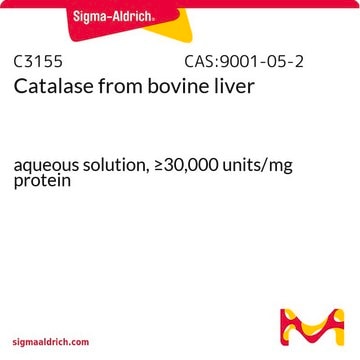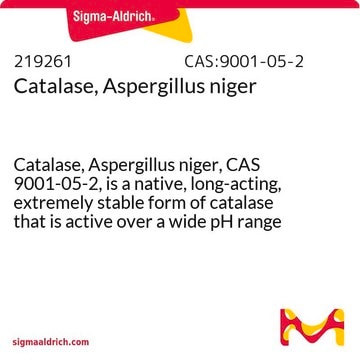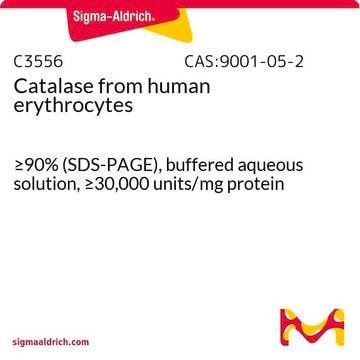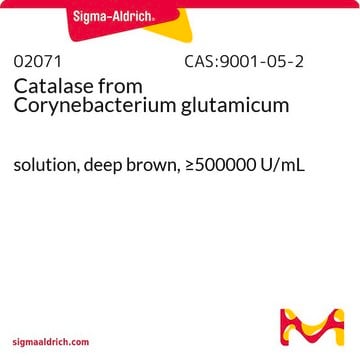This product is not assigned an expiration date or recommended retest date. Products with no expiration date or recommended retest date should be routinely inspected by customers to ensure they perform as expected. These products are also subject to a one year warranty from the date of shipment. For more information, you may access the "Product Dating Information" document under "ADDITIONAL USEFUL DOCUMENTS ABOUT OUR PRODUCTS" at the bottom of the Quality Services page with this link: https://www.sigmaaldrich.com/life-science/quality-and-regulatory-management/quality-services.
C30
Catalase from bovine liver
aqueous suspension, 10,000-40,000 units/mg protein
Sinônimo(s):
Bovine hepatocatalase, H2O2:H2O2 oxidoreductase
Selecione um tamanho
R$ 664,00
Disponível para enviar em31 de março de 2025Detalhes
Selecione um tamanho
About This Item
R$ 664,00
Disponível para enviar em31 de março de 2025Detalhes
Produtos recomendados
fonte biológica
bovine liver
Formulário
aqueous suspension
atividade específica
10,000-40,000 units/mg protein
peso molecular
tetramer ~250 kDa
concentração
20-50 mg/mL
técnica(s)
GC/MS: suitable
ponto isoelétrico
5.4
nº de adesão UniProt
Condições de expedição
wet ice
temperatura de armazenamento
2-8°C
cadeia de caracteres SMILES
O(CC)C(=O)c1ccc(cc1)O
InChI
1S/C9H10O3/c1-2-12-9(11)7-3-5-8(10)6-4-7/h3-6,10H,2H2,1H3
chave InChI
NUVBSKCKDOMJSU-UHFFFAOYSA-N
Informações sobre genes
cow ... CAT(280743)
Procurando produtos similares? Visita Guia de comparação de produtos
Descrição geral
Research area: Cell Signaling
Catalase from bovine liver is a tetramer consisting of 4 equal subunits each with a 60 kDa molecular weight. Each of these subunits contains iron bound to a protoheme IX group. The enzyme will also strongly bind to NADP, where NADP and the heme group are within 13.7 angstroms.
Aplicação
Catalase from bovine liver may be used:
- to prepare H2O2-O2 based biocathode for applications in glucose biofuel cells
- to study the kinetic properties and storage stability of catalase immobilized on to florisil
- in glutathione-mediated superoxide generation in an aqueous solution
- Dielectrophoretic field-flow fractionation (DEP-FFF): It is a chromatographic method in which cell elution times reflect the positions of cells in a hydrodynamic flow profile under the control of sedimentation, DEP and hydrodynamic lift forces, FSED, FDEP and FHDL, respectively. The DEP-FFF buffer consists of catalase along with other ingrediants.[5][6]
- GC-MS analyses.[7]
- Deionization.[8]
- GC-FID analysis.5
- Functional analysis of blood vessel.[9]
Ações bioquímicas/fisiológicas
Atenção
Definição da unidade
Nota de preparo
Armazenamento e estabilidade
persons
Inibidor
anticorpo
produto relacionado
Palavra indicadora
Danger
Frases de perigo
Declarações de precaução
Classificações de perigo
Resp. Sens. 1
Código de classe de armazenamento
13 - Non Combustible Solids
Classe de risco de água (WGK)
WGK 1
Ponto de fulgor (°F)
Not applicable
Ponto de fulgor (°C)
Not applicable
Equipamento de proteção individual
Eyeshields, Gloves, multi-purpose combination respirator cartridge (US), type N95 (US)
Escolha uma das versões mais recentes:
Certificados de análise (COA)
Não está vendo a versão correta?
Se precisar de uma versão específica, você pode procurar um certificado específico pelo número do lote ou da remessa.
Já possui este produto?
Encontre a documentação dos produtos que você adquiriu recentemente na biblioteca de documentos.
Os clientes também visualizaram
-
What is the stability of the product in 4deg?
1 answer-
Helpful?
-
Active Filters
Nossa equipe de cientistas tem experiência em todas as áreas de pesquisa, incluindo Life Sciences, ciência de materiais, síntese química, cromatografia, química analítica e muitas outras.
Entre em contato com a assistência técnica












